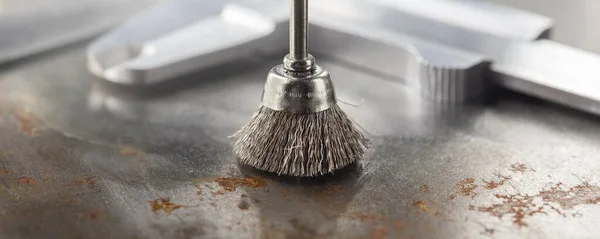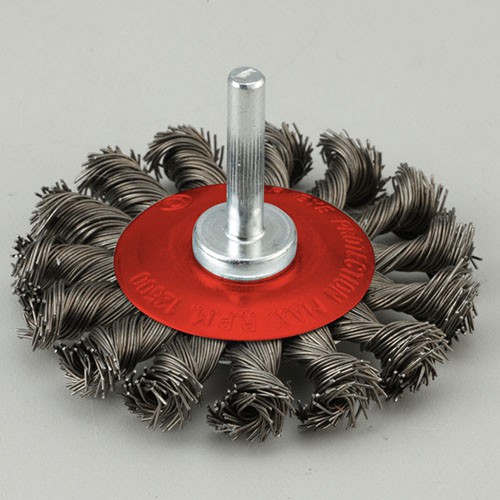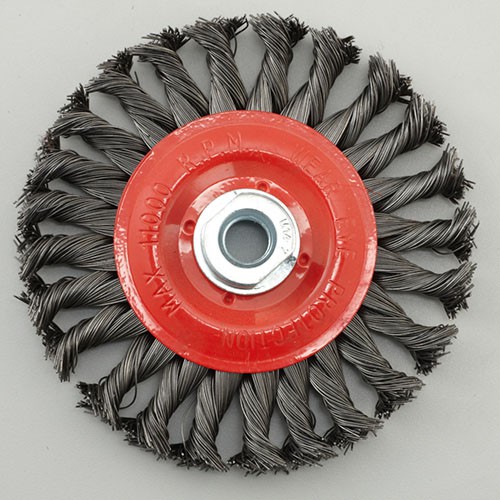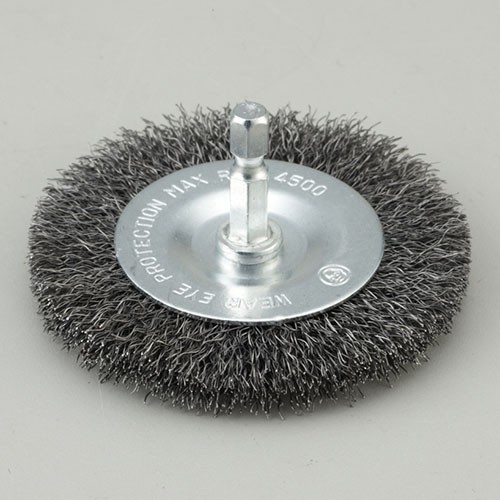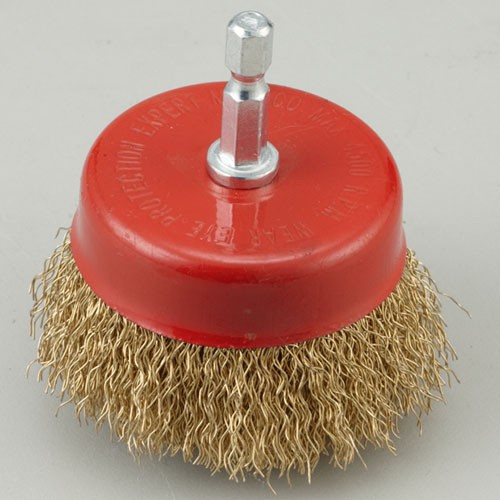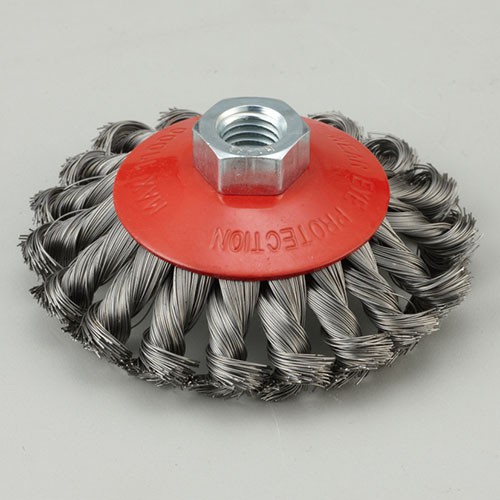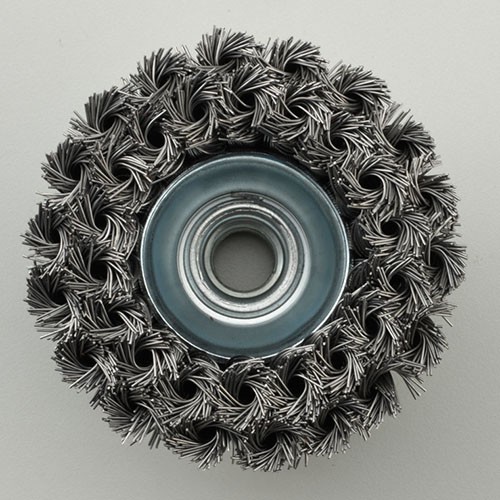A wire brush is a type of tool that consists of a handle and bristles made of stiff wire. It is used for various purposes, such as removing rust, cleaning metal surfaces, or scrubbing hard-to-reach areas. Wire brushes come in different shapes, sizes, and designs to suit various applications, and they can be powered by hand, machine, or electricity.
What types do wire brushes include?
Wire brushes come in a variety of types, each for specific applications.
A cup-shaped wire brush used for heavy-duty surface preparation and deburring, typically mounted on an angle grinder or power drill. Cup brushes come in various sizes, with different wire types, and can be used on various materials like metal, wood, and masonry.
A cup-shaped wire brush used for heavy-duty surface preparation and deburring, typically mounted on an angle grinder or power drill. Cup brushes come in various sizes, with different wire types, and can be used on various materials like metal, wood, and masonry.
A circular brush typically mounted on a bench grinder, used for cleaning and polishing surfaces. Circular brushes come in various sizes and wire types, and are used for applications like surface preparation, rust and paint removal, and finishing.
A brush with crimped bristles that is used for surface preparation, cleaning, and finishing, often used on bench grinders or rotary tools. Crimped wire wheel brushes come in various diameters and wire types, and are suitable for various materials like metal, wood, and plastic.
A brush with tightly twisted bristles that is used for heavy-duty applications, such as rust removal and weld cleaning, often used on angle grinders. Twist knot wheel brushes come in various sizes and wire types, and are suitable for various materials like steel, cast iron, and concrete.
Brushes mounted on a shaft, typically used in power drills, for cleaning and deburring. Shaft mounted brushes come in various sizes and wire types, and can be used on various materials like metal, wood, and plastic.
Similar to shaft-mounted brushes, but with bristles only on the end, making them suitable for reaching tight spaces. Shaft mounted end brushes come in various sizes and wire types, and are used for applications like weld cleaning, deburring, and polishing.
A brush made with nylon bristles that are impregnated with abrasive particles, used for light to medium-duty surface preparation. Nylon abrasive brushes come in various sizes and grits, and are suitable for materials like wood, plastic, and metal.
A brush made with plastic bristles, suitable for cleaning delicate surfaces or removing paint and coatings. Plastic wire brushes come in various sizes and shapes, and are used for applications like removing paint from window frames, cleaning car interiors, and polishing jewelry.
A brush with wooden bristles, suitable for cleaning irregular surfaces and for finishing wood. Wooden wire brushes come in various shapes and sizes, and are used for applications like removing paint from wooden surfaces, cleaning wooden decks, and polishing wooden furniture.
A set of brushes of various sizes and types, often used for a range of applications in cleaning and surface preparation. Brush kits typically include cup brushes, bevel brushes, circular brushes, and various other types of brushes, and are suitable for both DIY and professional use.
Wire brushes come in a variety of types to suit a wide range of cleaning and surface preparation tasks. By understanding the differences between these types, you can choose the right wire brush for your specific needs and achieve the best possible results.
Application scenario and industry of different wire brushes
- Cup Brush: Used in heavy-duty surface preparation, weld cleaning, and deburring applications on metal, masonry, and wood. Industries that use cup brushes include metal fabrication, construction, and woodworking.
- Bevel Wire Brush: Used for chamfering edges and cleaning corners on metal surfaces. Industries that use bevel wire brushes include metal fabrication and automotive repair.
- Circular Brush for Bench Grinder: Used for cleaning and polishing surfaces, removing rust and paint, and preparing surfaces for painting or coating. Industries that use circular brushes include metal fabrication, woodworking, and automotive repair.
- Crimped Wire Wheel Brush: Used for surface preparation, cleaning, and finishing on metal, wood, and plastic surfaces. Industries that use crimped wire wheel brushes include metal fabrication, woodworking, and automotive repair.
- Twist Knot Wheel Brushes: Used for heavy-duty applications like weld cleaning, rust removal, and surface preparation on metal, concrete, and masonry surfaces. Industries that use twist knot wheel brushes include metal fabrication, construction, and shipbuilding.
- Shaft Mounted Brushes: Used for cleaning and deburring on metal, wood, and plastic surfaces, in industries like metal fabrication, woodworking, and automotive repair.
- Shaft Mounted End Brushes: Used for reaching tight spaces and deburring on metal surfaces, in industries like metal fabrication, aerospace, and automotive repair.
- Nylon Abrasive Brushes: Used for light to medium-duty surface preparation, cleaning, and finishing on metal, wood, and plastic surfaces. Industries that use nylon abrasive brushes include woodworking, automotive repair, and electronics.
- Plastic Wire Brushes: Used for cleaning delicate surfaces, removing paint and coatings, and polishing on metal, wood, and plastic surfaces. Industries that use plastic wire brushes include automotive repair, marine, and jewelry making.
- Wooden Wire Brushes: Used for cleaning irregular surfaces and finishing wood on furniture, decks, and floors. Industries that use wooden wire brushes include woodworking, furniture manufacturing, and construction.
- Brush Kits: Used for a range of applications in cleaning and surface preparation, in industries like automotive repair, metal fabrication, and woodworking. Brush kits are suitable for both DIY and professional use.
What you should consider when using different wire brushes?
- Safety: Wear appropriate personal protective equipment, such as safety glasses, gloves, and a dust mask, when using wire brushes.
- Speed: Make sure the speed of the wire brush matches the maximum speed of the tool being used. Exceeding the recommended speed can cause the wire brush to break or wear out prematurely.
- Pressure: Use light to moderate pressure when using wire brushes. Excessive pressure can damage the wire brush and the workpiece.
- Angle: Use the wire brush at the recommended angle to avoid damaging the workpiece or causing the wire brush to wear out quickly.
- Material: Select the appropriate wire brush material for the workpiece. For example, use a steel wire brush for metal surfaces and a nylon brush for delicate surfaces.
- Application: Use the appropriate type of wire brush for the application. For example, use a cup brush for heavy-duty surface preparation, a twist knot wheel brush for weld cleaning, and a nylon abrasive brush for light surface preparation.
- Maintenance: Clean the wire brush regularly to remove debris and prevent buildup that can reduce the effectiveness of the brush.
Following these factors will ensure safe and effective use of different types of wire brushes for your specific application.
How to maintain your wire brushes?
Regular maintenance of wire brushes is important to ensure their effectiveness and longevity. Here are some tips for maintaining wire brushes:
- Clean the wire brush regularly: After each use, remove debris and buildup from the wire brush with a stiff-bristled brush or a wire brush cleaning tool. This will prevent the buildup from reducing the effectiveness of the brush.
- Store the wire brush properly: Store wire brushes in a dry, clean place, away from moisture and dirt. Hang the brushes or store them in a box to prevent damage to the bristles.
- Inspect the wire brush regularly: Check the condition of the bristles, the wire or shaft, and the connections to make sure there is no damage or wear.
- Replace the wire brush when necessary: Replace wire brushes when the bristles are worn down or damaged, or when the wire or shaft is bent or broken. Using a damaged wire brush can cause damage to the workpiece or the user.
- Lubricate the wire brush if necessary: Some wire brushes may require lubrication to prevent rust or corrosion. Follow the manufacturer’s recommendations for the type of lubricant to use and how often to apply it.
Conclusion
A wire brush is a tool that is used to remove rust, paint, and other materials from surfaces using wire bristles. There are various types of wire brushes, including cup brushes, bevel wire brushes, circular brushes, crimped wire wheel brushes, twist knot wheel brushes, shaft-mounted brushes, nylon abrasive brushes, plastic wire brushes, wooden wire brushes, and brush kits.
The application scenarios and industries for different types of wire brushes are varied, but they are commonly used in metalworking, automotive, construction, woodworking, and other industries where surface preparation is required.
When using wire brushes, it is important to consider safety, speed, pressure, angle, material, and application to ensure that the tool is used properly and effectively. Proper maintenance, including cleaning the brush, storing it correctly, inspecting it regularly, and replacing it when necessary, can help prolong the life of the wire brush.
In conclusion, wire brushes are versatile and effective tools for various industries and applications, and their safe and proper use can help ensure their longevity and effectiveness in surface preparation and other tasks.
Click here to visit our website : www.binictools.com to get more information.

